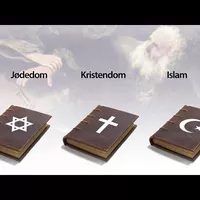13: Jødedommens historie
Jødedommen er den eldste av de tre abrahamittiske religionene, -
jødedommen, kristendommen og islam, med sin cirka 3000 år lange historie.
Alle disse tre er monoteistiske og knytter seg på forskjellig vis til Abraham.
Jødenes tidlige historie går som en rød tråd gjennom den jødiske bibelen Tanakh.
Tanakh tilsvarer omtrent det de kristne kaller Det Gamle Testamentet.
Koranen i islam inneholder også mange av de samme mytene som man finner i Tanakh.
Ordet Tanakh er satt sammen av første bokstav i de tre hoveddelene som boken består av:
Tora - Loven, Neviim - profetene og Ketuvim - skriftene.
Toraen begynner med de skapelsen og historien om Adam og Eva.
Her fortelles også historien om syndefloden og Noahs ark.
Men det er først med Abraham at jødenes historie begynner.
Ifølge jødedommen inngikk Abraham og Gud en pakt for omtrent 3000 år siden, -
der Abraham forpliktet seg til å følge den ene gud.
Abraham skulle reise til landet Kanaan ved Middelhavets østlige bredd, -
der han skulle slå seg ned og få mange etterkommere.
Som tegn på pakten skulle han la alle guttebarn omskjære.
Dette er en helt grunnleggende myte for for jødenes syn på seg selv som et folk -
med spesielle forpliktelser overfor Gud og med et spesielt forhold til landområdet som i dag utgjør Israel og områdene rundt.
Mye av Toraen vies til fortellingen om Moses, hvordan han reddet sitt folk fra slaveri i Egypt og lovene han mottok fra Gud.
Toraen tilsvarer Mosebøkene i det gamle testamentet.
Etter Moses' død skal Kanaan ha blitt gjenerobret av det jødiske folk.
Etter en urolig periode, den såkalte “dommertiden”, fikk jødene sitt første samlede kongedømme i 1020 f.Kr.
Den første kongen var Saul.
Hans etterfølger David skapte ifølge tekstene et sterkt forent monarki med Jerusalem som hovedstad.
Denne perioden kalles kongetiden.
Under hans etterfølger Salomo, var det en periode med fred og vekst og det første tempelet i Jerusalem ble bygget.
Omkring 930 f.Kr. ble kongedømmet delt i to riker, Israel i nord og Judea i sør.
På 600 tallet f.Kr. erobret den babylonske kongen Nebukadnesar II Jerusalem, og ødela tempelet.
Store deler av den jødiske befolkningen ble deportert til Babylon og holdt som fanger der.
Jødedommen måtte tilpasse seg en tilværelse uten Tempelet.
Flere tradisjoner og forestillinger som vi kjenner fra dagens jødedom ble trolig til nettopp under det babylonske fangenskap.
Da perserne erobret Babylon i 539 f.Kr fikk jødene vende tilbake, -
men ikke alle benyttet seg av dette da mange var godt etablert i Babylon.
De tilbakevendte jødene gjenoppbygget det andre tempelet i Jerusalem omkring 537 f.Kr.
Judea ble romersk provins i 63 f.Kr. I år 66 e.Kr gjorde jødene opprør mot Romerriket.
Romerske legioner erobret og ødela det meste av Jerusalem og det andre tempelet i år 70 e.Kr.
Dette førte til den jødiske diasporaen, hvor jødene i store antall ble forvist fra sitt hjemland og ble spredt ut over hele Romerriket.
Religionen var nå ikke lenger sentrert rundt prestenes ritualer i tempelet i Jerusalem, men rundt synagoger og rabbinere.
Fram til ca 500 e.Kr. ble jødenes omfattende muntlige tradisjon systematisert, skrevet ned og samlet i Talmud.
Alle disse endringene har har vært avgjørende for jødedommen slik vi kjenner den i dag.
Jødene ble stadig utsatt for forfølgelser i middelalderen, hovedsakelig i det kristne i Europa.
En av årsakene var at jødene fikk skylden for drapet på Jesus.
Forfølgelsene skjedde både før og etter reformasjonen.
Ikke minst ble mange jøder offer for 1600-tallets kjetter- og hekseprosesser.
På attenhundretallet økte interessen for jødisk nasjonalisme, og dette fikk sitt uttrykk i sionistbevegelsen -
etter høyden Zion i Jerusalem som symbol på landet Israel.
Sionistene støttet etableringen av et eget jødisk hjemland i det historiske Israel.
I siste halvdel av attenhundretallet økte populariteten av raseteorier, og antisemittismen når sitt høydepunkt med Holocaust.
6 millioner jøder, over halvparten av alle jøder i Europa - ble systematisk utryddet av det tyske nazistiske regimet i perioden 1938 til 1945.
Etter krigen var det svært mange overlevende jøder som dro fra det krigsherjede Europa til det britisk styrte Palestina.
Det ble et økt internasjonalt press for opprettelsen av en jødisk stat.
I 1947 vedtok FN en plan om å dele Palestina i en jødisk og en arabisk stat.
Jerusalem skulle være under internasjonal administrasjon.
Ingen av partene i området godtok planen, og rett før den skulle settes i verk kunngjorde sionistlederen David Ben-Gurion etableringen av den jødiske staten Israel.
Delingen i en arabisk og en jødisk del ble derfor aldri noe av.
Siden 1948 har området vært preget av konflikt om landegrenser.
Det bor per 2018 cirka 9 millioner mennesker i Israel, hvor cirka 75% regner seg som jøder.
I 2016 ble det anslått å være et sted mellom 14 og 18 millioner jøder i verden. De fleste bor i Israel og USA.

